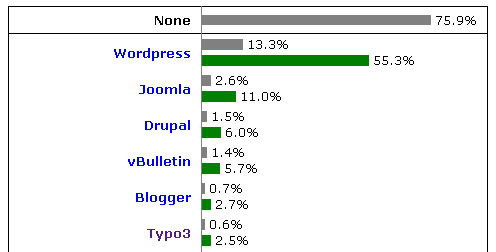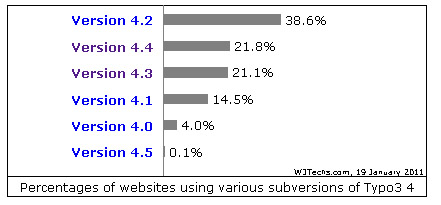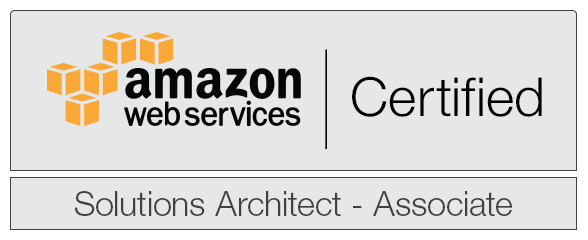Have you ever wondered how much is TYPO3’s share in the CMS market? Well, i did. And if you didn’t know there are some websites that have these statistics and they update them near real time.
One of these sites is W3Techs , a website which monitor lots of things and among other things they also monitor CMS software market shares. According to them TYPO3 is in the 6th place
 (source)
(source)
From this graph we can see that 75.9% of the websites aren’t using any CMS. From those who use CMS, TYPO3 has a market share of 2.5% (0.6% from the global share including non-CMS websites).
The leading CMS is WordPress with more then half of the CMS installations being on this platform. Second is Joomla, which surprises me, Joomla in my opinion isn’t a too bright CMS, being plagued by security holes and the lack of free modules for it is annoying.Drupal comes in 3rd place, which surprises me again, i’ve been expecting Drupal on the second place. Certainly in my point of view Drupal is better then Joomla at any task.
Place 4 is taken by vBulletin which as i know it is mostly used for forums (although it has some CMS functions added recently – i don’t hink people use it for that purpose) and its place in the CMS category is open for discussion. Place 5 goes to Google’s Blogger, which again can be considered a CMS but in reality is a blogging platform which is pushed hard by Google and which isn’t offered for the users to download, modify, use.
If we go forward and analyze TYPO3 further we will see that there are still 2.3% of websites wich use version 3.x of TYPO3. That version is so ancient that i wonder how these people manage to keep their website up and running. TYPO3’s versions greater then 4 are used by 97.7% of the TYPO3 users.

(source)
If we further analyze this breakdown and see how the 4.x branch is doing, then we will have some little surprises.
 (source)
(source)
It seems that more then one third of the TYPO3 4.x branch is ruled by versions 4.2.x and about 21% for 4.3.x and 4.4.x. This is bad news because the 4.2 branch support is being discontinued this month when TYPO3 4.5 LTS (Long Term Support) appears. Users running TYPO3 4.2.x will need to upgrade soon in order to have their versions supported. This is also valid for the 14.5% who use TYPO3 4.1.x which is obsolete and not supported since last july and users of the 4.0.x branch which is not supported for more then a year. You can see the TYPO3 support matrix here
Overall TYPO3 could do better, and will do better. Version 4.5 will be Long Term Support and probably many people are just waiting for this version to appear and will be upgrading to it. Now that TYPO3 has an Introduction Package that makes learning TYPO3 easier and the availability of the TYPO3 Distributions should bolster the adoption among people who didn’t used it before.
Meantime i will be continuing to monitor TYPO3’s market share and plan to provide a report on this blog every six months about the TYPO3’s market share and the evolution of the market share.
What is your opinion on this data ? How do you think that TYPO3 usage can be increased ?




10 comments
Nice aggregation! Looking forward to more posts like this to see how the stats evolve in time.
For TYPO3 and drupal: Both aim to solve the same level of problems (mid- and enterprise), the other mentioned “CMS” are simply in some other category. In fact, TYPO3 is so powerful, it should be put in a category in itself.
Thus, it would be great to see more statistics comparing more complex sites and which (commercial and open) systems are used to satisfy needs.
@lolli
As i said in the post, i don’t consider vBulletin or Blogger to be true CMS software. W3Tech choose to consider them, but in the future i could make more detailed analysis and remove software that doesn’t fit in the open CMS category or present them in a different table as you suggested.
I agree with your point that TYPO3 is so powerful that it shouldn’t be in the CMS category because none of the mentioned products can compete with TYPO3 in terms of features, complexity and performance.
Interesting and well researched article.
With version 4.2 being unsupported soon, do we have to worry about typo3.com then, because that is what they are running at the moment: http://w3techs.com/sites/info/typo3.com
Unfortunately, as interesting as this data is, it is comparing apples to oranges. The only software that is comparable to TYPO3 on the list is Drupal, and possibly Joomla. WordPress may be a CMS, but to get it even remotely to do the things TYPO3 and Drupal can do require tons of work and a huge learning curve, including ability to program. The reason that the data is skewed toward WordPress and Joomla is that these two are widely used by individuals. There is no doubt that WordPress is the top blogging software. Programs like TYPO3 and Drupal should be compared to other systems that have similar capabilities.
@Virgil
I totally agree with you that you can’t compare WordPress to TYPO3 or Drupal. Not even Drupal to TYPO3. As @lolli said before TYPO3 is so powerful that it should have its own category. But unfortunately the rest of the world considers them all in the same category named CMS.
@Sed
Great find! I suppose they have so many things there that migrating TYPO3.org is quite difficult. Nevertheless it should be done.
I think as long as we remain aware of the overly-broad use of the term ‘CMS,’ this is valuable information. Agreed that WordPress and Typo3 both manage content, but that’s about where the similarities end. This is like lumping bicycles and elevators together because they both transport people. As far as it goes, this is important analysis, mainly because it mirrors the view that 90% of Internet users have of what a CMS is.
But, WordPress and Joomla serve a different market. They provide simplified tools enabling relatively non-technical end-users to easily go live fast. They do this very well, and so have earned their position.
I think equally important is to compare Typo3 with systems that have the potential to solve the more complex problems (or use cases) that Typo3 excels at. I think this would include Drupal and Ruby on Rails.
It is not irrelevant that this discussion is happening on a WordPress site, and that the site serves the need very well.